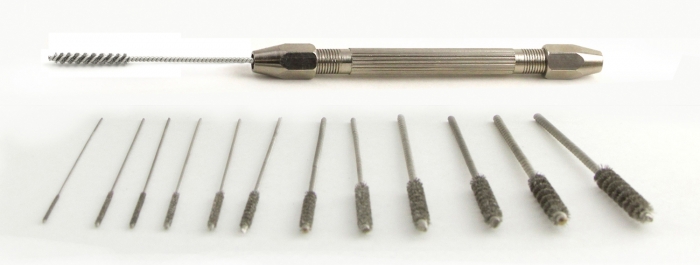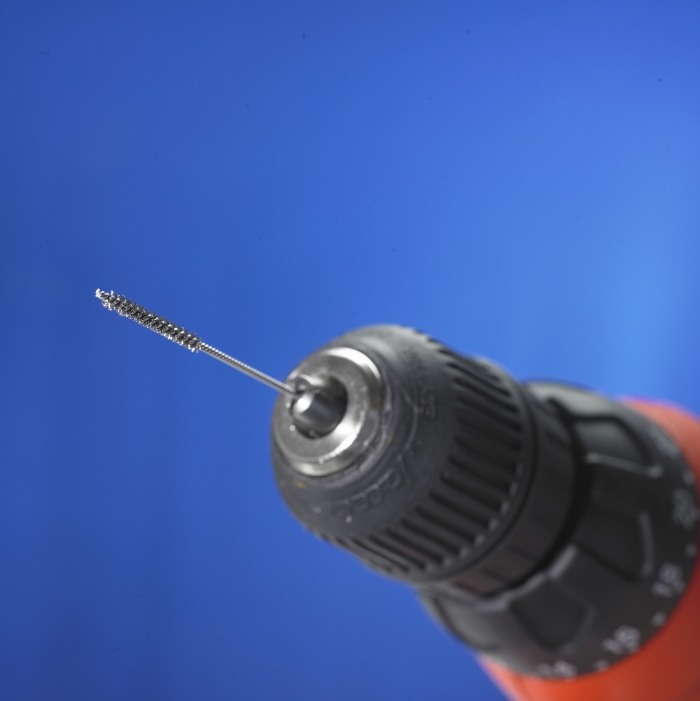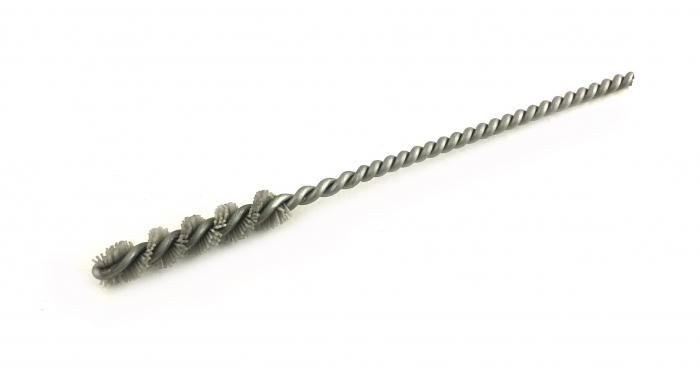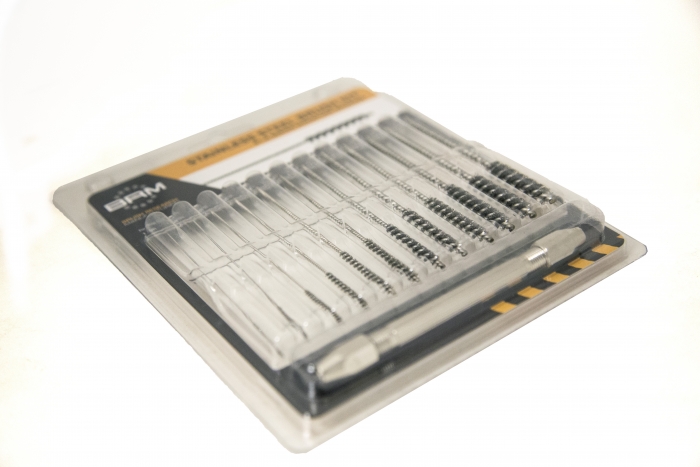Article from Brush Research Manufacturing Co. Inc.
If you read the online forums, it is immediately clear that identifying the optimal technique for removing the inevitable burrs created during machining of threaded parts is the subject of much debate.
Internal threads – whether cut, rolled or cold-formed – can have burrs at hole entrances and exits, on thread crests and on most slot edges. External threads on bolts, screws and spindles have similar issues, particularly at the start of the thread.
For larger threaded parts, burrs can be removed by retracing the cutting path, but this increases the cycle time for each part. Secondary operations, such as heavy nylon deburring tools or butterfly brushes can also be used.
However, the challenges increase substantially when the diameter of the threaded part or tapped holes measure less than 0.125”. When this is the case, microburrs are still created, but are small enough that removal is more a matter of polishing, than aggressive deburring.
At this point, in the miniature range, the choice of deburring solutions narrows considerably. Mass finishing techniques can be used, such as tumbling, electrochemical polishing and thermal deburring, but these require the parts to be sent out at additional cost and loss of time.
For many machine shops, however, the preferred solution is to keep secondary operations such as deburring in house. Either automated using CNC machines or using hand drills or even manual techniques.

Fortunately, there are miniature brushes that – despite a tiny stem, filaments and overall dimensions – can be rotated using hand drills and even using adaptors on CNC equipment. Now available with abrasive nylon, carbon steel, stainless steel and diamond abrasive filaments, these tools are available as small as 0.014”, depending on the type filament.
Given the potential for burrs to affect the form, fit or function of a product, the stakes are high for products that have microthreads, including items like watches, eyeglasses, cell phones, digital cameras, printed circuit boards, medical devices and aerospace parts.
The risks include misalignment of joined parts, difficulties in assembly, burrs that can become loose and contaminate hygienic systems and even fastener failure in the field. As a result, burr removal remains a critical finishing operation.

Mass Finishing Techniques for Deburring
Mass finishing techniques such as tumbling, thermal deburring and electrochemical polishing can be effective for removing some light burrs on small parts.
Tumbling, for example, can be used to remove some burrs but is not generally effective on the ends of threads. Furthermore, care is required to prevent mashing burrs into thread valleys, which can interfere with assembly.
When burrs are on internal threads, mass finishing techniques must be able to reach deep into internal structures.
Thermal deburring, for example, utilizes heat energy that approaches several thousand degrees Fahrenheit to attack burrs from all sides. Because the heat cannot transfer from the burr to the parent material, the burr is only burned down to the parent material. As such, thermal deburring does not affect any dimensions, surface finish or material properties of the parent part.
Electrochemical polishing is also used for deburring and works my leveling out any micropeaks, or burrs. Although the technique is effective, there is still some concern it could affect the threads. Still, generally speaking, material removal conforms to the shape of the part.
Despite the potential issues, the low cost of mass finishing still makes it an appealing process for some machine shops. However, as already noted, machine shops prefer to keep secondary operations in-house if possible.

Miniature Deburring Brushes
For threaded parts and machined holes less than 0.125”, miniature metalworking brushes are an affordable tool to remove small burrs and perform internal polishing.
Miniature brushes come in various small sizes (including kits), contours and materials. These tools are best suited to address tight tolerances, edge blending, deburring and other finishing requirements.
“Machine shops come to us for miniature brushes because they do not want to outsource the parts anymore and want to do that work in-house,” said Jonathan Borden, national sales manager of Brush Research Manufacturing. “With a miniature brush, they no longer have to worry about the lead times and extra coordination to send parts out and bring them right back in.”
As a full-line supplier of surface finishing solutions, Brush Research Manufacturing offers miniature deburring brushes in a variety of filament types and tip styles. The company’s smallest diameter brush measures only 0.014".
The miniature deburring brushes can be used by hand. However, because the brush stem wires are very fine and may bend, the company recommends using a pin vise. The company offers a double-end pin vise in kits with up to 12 brushes in both decimal (0.032” to 0.189”) and metric hole sizes (1mm to 6.5mm).
The pin vises can also be used to grip the small-diameter brushes to allow them to be rotated under power on a handheld drill and CNC machine.
Miniature brushes can also be used on external threads, to remove small burrs that can form at the start of the thread. These burrs can cause problems and should be removed, because any displaced metal can cause critical and potentially hazardous situations in industries that require exceptional precision and cleanliness.
To prevent deflection of the twisted wire stem of the brush, CNC equipment can be programmed to apply the precise pressure and rotational speed.

“These kinds of deburring operations – even with very small diameter miniature brushes – can be automated,” Borden said. “You can use the tools on CNC machines using the pin vise or by making an adapter.”
There are several types of miniature brushes available today that vary not just in size, but also filament type. Carbon steel, stainless steel, brass, nylon and abrasive-filled nylon are commonly used. Abrasive-filled nylon can contain silicon carbide, aluminum oxide or diamond abrasive.
According to Borden, abrasive nylon is particularly effective for removing burrs and polishing thread peaks and flank angles in tapped aluminum holes.
“If you cut a single-point thread in aluminum or the part was threaded using diamond tooling, there will be a lot of ‘fuzz’ and rough thread flank angles that need to be polished,” Borden said.
Miniature stainless-steel brushes are popular for more aggressive deburring of materials like cast iron or steel to remove chips or clear break-through burrs. Although abrasive nylon miniature brushes are available as small as 0.032", due to the nature of the stainless steel, Brush Research was able to add three smaller brush sizes: 0.014”, 0.018” and 0.020”.
Brush Research also supplies miniature deburring brushes with diamond abrasive filaments for harder materials such as hardened steel, ceramic, glass, and aerospace alloys.
“The choice of filament depends on the surface finish specifications, or if there is a need for a little more aggressive deburring power,” Borden said.
Borden said other factors apply to miniature brushes used in automated applications include spindle speed of the machine tool, feed rates, and optimal wear life.
Although deburring of internal and external microthreads can be challenging, using the most suitable tools for a given application can simplify the task and assure all burrs are consistently removed on every part. In addition, by avoiding outsourcing of secondary deburring operations, machine shops can reduce turnaround time and price per part.
Related Glossary Terms
- abrasive
abrasive
Substance used for grinding, honing, lapping, superfinishing and polishing. Examples include garnet, emery, corundum, silicon carbide, cubic boron nitride and diamond in various grit sizes.
- alloys
alloys
Substances having metallic properties and being composed of two or more chemical elements of which at least one is a metal.
- aluminum oxide
aluminum oxide
Aluminum oxide, also known as corundum, is used in grinding wheels. The chemical formula is Al2O3. Aluminum oxide is the base for ceramics, which are used in cutting tools for high-speed machining with light chip removal. Aluminum oxide is widely used as coating material applied to carbide substrates by chemical vapor deposition. Coated carbide inserts with Al2O3 layers withstand high cutting speeds, as well as abrasive and crater wear.
- burr
burr
Stringy portions of material formed on workpiece edges during machining. Often sharp. Can be removed with hand files, abrasive wheels or belts, wire wheels, abrasive-fiber brushes, waterjet equipment or other methods.
- computer numerical control ( CNC)
computer numerical control ( CNC)
Microprocessor-based controller dedicated to a machine tool that permits the creation or modification of parts. Programmed numerical control activates the machine’s servos and spindle drives and controls the various machining operations. See DNC, direct numerical control; NC, numerical control.
- feed
feed
Rate of change of position of the tool as a whole, relative to the workpiece while cutting.
- metalworking
metalworking
Any manufacturing process in which metal is processed or machined such that the workpiece is given a new shape. Broadly defined, the term includes processes such as design and layout, heat-treating, material handling and inspection.
- polishing
polishing
Abrasive process that improves surface finish and blends contours. Abrasive particles attached to a flexible backing abrade the workpiece.
